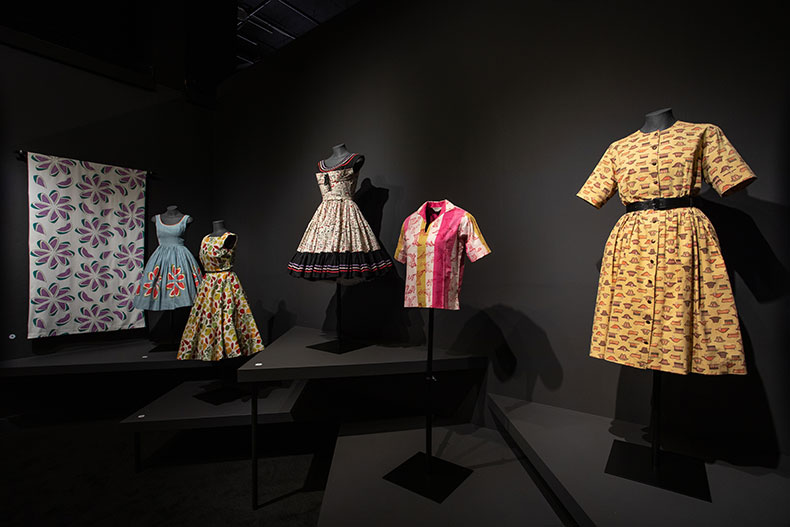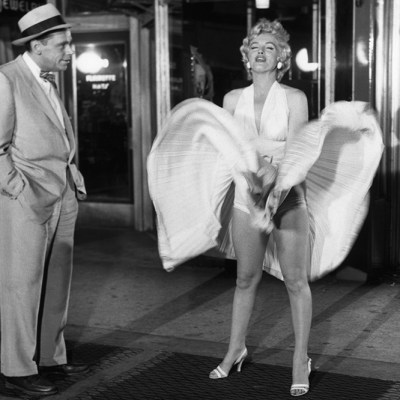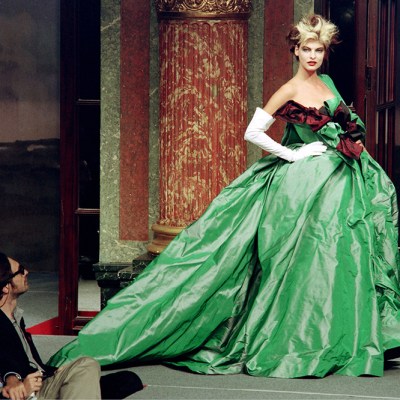Andy Warhol’s career began, not with soup cans and Marilyns, but as a commercial artist. After training at the Carnegie Institute of Technology in his hometown of Pittsburgh, Warhol moved to New York in 1949, where he began producing fashion and advertising illustrations and designs for products such as book covers, gift-wrap and greetings cards. It was on the foundations of this successful career that Warhol built his Pop empire. Less known and less explored, however, at least until now, are his commercial designs for textiles. ‘Andy Warhol: The Textiles’ at the Fashion and Textile Museum in London is the first exhibition dedicated to this aspect of Warhol’s pre-Pop career.
Textile of ice cream cones, silk by Stehli Silks. Photo: © 2022 The Andy Warhol Foundation for the Visual Arts, Inc./Licensed by DACS, London

Warhol designed commercial textiles for several manufacturers for nearly a decade from the mid 1950s. The resulting fabrics were then transformed into garments by individuals or boutiques. Mounting an exhibition of Warhol’s textiles, however, encounters the issue of a lack of solid documentation. Warhol, and other graphic artists, sold textile designs anonymously through agents in the Garment District in New York. Labels in surviving garments made from the textiles name the garment manufacturer, not the textile manufacturer or designer. It’s also difficult to work out from Warhol’s own records for the period exactly what product is being referred to. ‘Some of Warhol’s pattern designs may have been for gift-wrap, rather than fabrics. They may also have been used for both these end products. The artist was always happy to oblige a paying client,’ says Matt Wrbican, chief archivist at the Andy Warhol Museum, Pittsburgh. Repeating design elements across media was not only sound commercial sense, it became fundamental to Warhol’s art.
While researching an earlier exhibition, curators Richard Chamberlain and Geoffrey Rayner had stumbled across a copy of Glamour magazine from 1960 that included an image of a dress made from a particular fabric: ‘Bright Butterflies, designed by Andy Warhol’. For around a decade, Chamberlain and Rayner scoured vintage stores and collections to track down fabrics which, on the basis of style, could have possibly been designed by Warhol. They then set about authenticating the fabrics as ‘Warhols’ through archival research, comparison to known illustrations and any available documentation.
Installation view of ‘Andy Warhol: The Textiles’ at the Fashion and Textile Museum, London. Courtesy the Fashion and Textile Museum

At the Textile Museum, bolts of fabric and garments are set against dark grey walls, spotlit and presented largely at eye level. This encourages close looking, essential for appreciating the intricacy of the designs. What at first appears to be a regular pattern of interlocking multi-coloured pretzels on violet background, for example, in fact contains subtle permutations. This, combined with the focus of the exhibition on the fabrics themselves, reveals Warhol’s textiles to be an important stage in his stylistic development. Not only is repetition of the same motif with slight variations already present (foreshadowing Warhol’s later serial work), so too is the artist’s fascination with the everyday. During the decade before produced hundreds of Brillo or Kellogg’s Cornflakes boxes as sculptures, he was creating textiles covered in hats, brooms and luggage labels. The way in which Warhol produced his textile designs (as well as other graphic work in this period) prefigured the assembly-line style production employed in his Factory. In this case, Warhol’s original drawings, or sections of them, were traced with ink and the tracing was pressed on to absorbent paper. This allowed motifs to be reused, in different combinations, either by Warhol or his assistants. As Blake Gopnik has suggested, Warhol’s designs for textiles would have acquainted him with the screen-printing process that soon took on a key role in his later, and now most recognisable, works.
Textile of luggage tags and suitcases by Cohama. Photo: © 2022 The Andy Warhol Foundation for the Visual Arts, Inc./Licensed by DACS, London

Andy Warhol and his art has been scrutinised, discussed and exhibited from many angles since his untimely death in 1987. He may be one of the world’s best-known artists, but this exhibition proves that there is still much more to say.
‘Andy Warhol: The Textiles’ is at the Fashion and Textile Museum, London, until 10 September.



